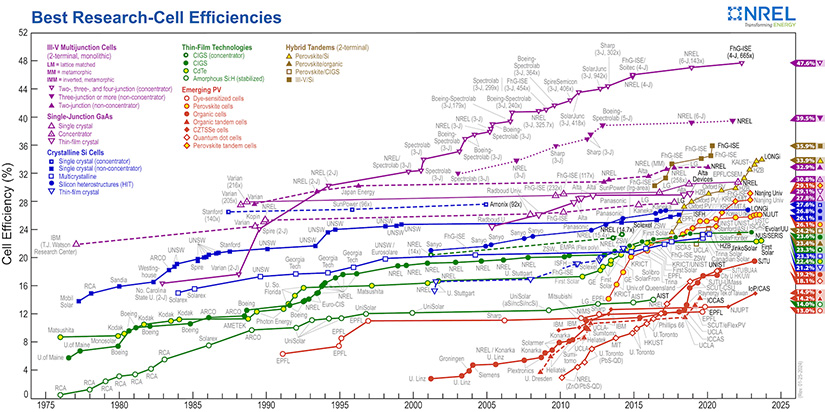Popular NREL Cell Efficiency Chart Now Better Presents Tandem Photovoltaics
NREL Photovoltaics Researchers Create a New Version of the Iconic Chart That Tracks World-Record PV Cells Across Many Technologies and Time
The Best Research-Cell Efficiency Chart is one of the most-visited pages on the National Renewable Energy Laboratory's (NREL's) website. It makes frequent appearances in presentations at photovoltaic (PV) research conferences, tracking the rise and maturation of new PV technologies.
Just like the technologies it tracks, the chart continues to evolve. Recently, NREL developed an interactive version of the chart and began publishing the underlying data table, allowing users to dive deeper.
Now, the NREL team responsible for maintaining the chart is implementing an update to the chart's technology categories.
Adding a Hybrid Tandem Category
Due to the growing interest in tandem PV (cells composed of two separate absorbing layers to capture more of the solar spectrum), the NREL team added a new "Hybrid Tandems" category to the chart. This category collects record tandem cells with layers composed of two different PV materials. Some subcategories of Hybrid Tandems (Perovskite/Si and Perovskite/CIGS) were already present in the previous format under "Emerging PV," whereas others (III-V/Si and Perovskite/organic) are new.
All of these subcategories have been moved into the new Hybrid Tandems category—with the exception of perovskite/perovskite tandems, which are listed under Emerging PV.
View the updated version below. The new changes are also reflected in the interactive version of the Best Research-Cell Efficiency Chart.

Condensing the III-V Multijunction Category
This updated version also makes changes to the "III-V Multijunction Cells" category, which has long contained the highest-efficiency cells on the chart. To simplify the very busy chart, all III-V concentrator cells are now combined into one subcategory, with the number of junctions stated at the label of each point. Three- and four-junction non-concentrator cells are also combined into a "Three-junction or more" subcategory.
A New Subcategory Under Emerging PV
With growing interest in and examples of independently verified efficiencies for all-perovskite two-terminal tandem cells, the NREL team also added a new subcategory under the Emerging PV category on the chart. The new "Perovskite tandem cells" subcategory will list the absolute record efficiency for all-perovskite, two-terminal tandems regardless of the number of junctions.
Overall, these changes reflect recent developments in new types of cells and make the chart a more complete reference for record cell efficiencies.
Call for Community Feedback
NREL is seeking input from the community of PV researchers and manufacturers on these changes to the Best Research-Cell Efficiency Chart. As a common fixture in the PV community, NREL wants to ensure these changes are beneficial.
Submit comments and feedback to [email protected].
Learn more about NREL's PV device performance research.
Check out the related Champion Photovoltaic Module Efficiency Chart.
For general questions about NREL's record efficiency charts and PV device performance research, contact Nikos Kopidakis.
Last Updated May 28, 2025
